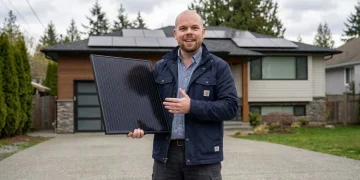
Solar Panels Roof After 25 Years in Canada The Truth
July 31, 2025
Solar Panels Newfoundland Labrador Guide For 2025
August 5, 2025Why Consider Solar Energy in Nunavut?
The number one reason to consider solar in Nunavut is to combat the territory’s extreme energy costs and its total reliance on diesel fuel. Every kilowatt of electricity is generated by burning diesel that has been shipped in at great expense. This results in some of the highest electricity rates in North America—as of 2025, residential customers are paying a staggering $0.7494 per kWh. That’s more than five times the average in southern Canada. Solar energy offers a direct path to reducing that heavy financial burden and gaining control over your energy bills.

Current State of Solar Power in Nunavut
Right now, Nunavut’s energy landscape is dominated by 25 independent diesel power plants, one for each remote community. But change is happening. Solar adoption is growing, moving from small-scale residential projects to larger, utility-involved installations. Qulliq Energy Corporation (QEC), the territory’s utility, is actively exploring and implementing solar projects. The current state is one of transition, where renewable energy is being proven as a viable supplement to the existing diesel infrastructure, with several successful projects already powering communities.
Future Trends and Projections for 2025
Looking ahead, the trend is clear: Nunavut is on a path toward hybrid energy systems. The federal and territorial governments are aligned in their goal to reduce diesel dependency. For 2025 and beyond, expect to see more funding programs, larger-scale solar farms integrated with battery storage, and a continued increase in residential solar adoption. The focus will be on creating resilient, cost-effective energy systems that combine the reliability of diesel with the clean, free fuel of the sun.

Understanding Solar Panel Technology
How Do Solar Panels Work?
It’s simpler than you might think. Solar panels are made up of many small photovoltaic (PV) cells. When sunlight hits these cells, it excites electrons within them, creating a direct current (DC) of electricity. This DC electricity then flows to a device called an inverter, which converts it into alternating current (AC) electricity—the standard type of power used in our homes. From there, it powers your lights and appliances, with any excess energy being sent to the grid.

What Types of Solar Panels Are Suitable for Nunavut?
Not all solar panels are created equal, especially when it comes to the Arctic. For Nunavut, the clear winner is the bifacial solar panel. Unlike traditional panels that only capture light from the front, bifacial panels have a transparent back, allowing them to capture reflected light as well. In an environment with snow on the ground for much of the year, this is a massive advantage. Snow acts like a giant mirror, reflecting sunlight up onto the back of the panels. This “albedo effect” can boost your system’s total energy production by 10-25%, making them perfectly suited for the northern climate.
Key Features to Look for in Solar Panels
When choosing panels for a Nunavut installation, here’s what to prioritize:
- Durability and Load Rating: The panels must be able to withstand heavy snow loads and high winds. Look for a high load rating, typically measured in Pascals (Pa).
- Cold Weather Performance: As I mentioned, panels work better in the cold. Check the panel’s temperature coefficient—a lower number means it loses less efficiency as temperatures rise, but more importantly, it indicates a design that handles temperature extremes well.
- A Solid Warranty: Look for a 25-year performance warranty and at least a 10-12 year product warranty. This ensures your investment is protected against defects.
Benefits of Installing Solar Panels in Nunavut
How Can Solar Panels Reduce Energy Costs?
This is where the numbers get exciting. With electricity at nearly 75 cents per kWh, every kilowatt-hour your panels produce is 75 cents you keep in your pocket. A standard 8 kW residential system can generate around 7,200 kWh per year, translating to over $5,300 in annual savings. When you factor in the powerful government incentives that can cover the majority of the upfront cost, the financial case becomes incredibly strong. The payback period in Nunavut is often faster than anywhere else in Canada.
What Are the Environmental Benefits?
Every solar panel installed in Nunavut directly reduces the amount of diesel that needs to be burned. This means less greenhouse gas emissions contributing to climate change and less local air pollution. It also reduces the constant noise from diesel generators and lowers the risk of catastrophic fuel spills in the sensitive Arctic ecosystem. It’s a tangible way to create a cleaner, healthier community.
How Do Solar Panels Contribute to Energy Independence?
On a personal level, generating your own power gives you a buffer against rising electricity rates. You become less dependent on the fluctuating price of diesel fuel. On a community level, a network of solar-powered homes creates a more resilient energy system. It decentralizes power generation, reducing the strain on the central power plant and making the entire community less vulnerable to fuel supply disruptions.
Challenges and Solutions for Solar Energy in Nunavut
What Are the Major Challenges for Solar Installations?
There are two main hurdles. First is the high upfront cost. All equipment must be shipped north, and skilled labor is more expensive. An installation can cost $4.00 per watt or more. Second are the logistics. The short shipping season means projects require meticulous planning. A single missing part can delay a project for a full year.
How to Overcome Weather and Geographic Limitations?
The solution isn’t to fight the environment, but to work with it. The “limitation” of the dark winter is overcome by harnessing the 24-hour daylight of the Arctic summer. During these months, systems are designed to overproduce and bank energy credits for the winter. The challenge of snow is turned into an advantage by using bifacial panels to capture reflected light, boosting overall production.

What Are the Financing Options Available?
This is a key part of the solution to the high upfront cost. While specific bank loans for solar are not common in the territory, the federal government’s Canada Greener Homes Loan is a critical tool. It provides an interest-free loan of up to $40,000 with a 10-year repayment term. This financing, when combined with the territorial grant, makes it possible to install a system with little to no money down.

Planning and Installing Solar Panels
What Are the Steps to Planning a Solar Installation?
I always advise a simple four-step approach:
- Assessment: Have a qualified installer evaluate your home’s roof, electrical system, and energy consumption to determine the right system size.
- Financing and Grants: Secure your financing through the federal loan and apply for the territorial grant. This should be done before signing any contracts.
- Logistics and Scheduling: Work with your installer to plan the shipping of materials to align with the sealift schedule and coordinate the installation timeline.
- Installation and Commissioning: The installation crew will mount the panels and connect the system. The final step is getting approval from QEC to connect to the grid.
How to Choose a Reliable Solar Installation Company?
Choosing the right partner is crucial. You need a company that understands the North. From my experience with a complex project in Northern Quebec, I can tell you that a good installer is first and foremost a logistics expert.
Ask them these questions:
- Can you provide references from other northern projects?
- How will you manage the shipping and ensure all parts arrive on time?
- Are you experienced with the Nunavut grant and QEC interconnection processes?
- What is your warranty on workmanship in this climate?
What Are the Maintenance Requirements?
Solar panels are surprisingly low-maintenance. In Nunavut, the primary task is clearing snow off the panels after a heavy storm to ensure they can start producing as soon as the sun is out. A simple, long-handled snow rake is usually all that’s needed. Beyond that, an annual visual inspection to check for any damage is a good practice.
Government Policies and Incentives
What Government Incentives Are Available in 2025?
The incentive landscape in Nunavut is extremely generous. As of 2025, homeowners can access two main programs:
| Incentive Program | Details |
| Renewable Energy Homeowner Grant (NU) | Covers 50% of total project costs, up to a $30,000 maximum. |
| Canada Greener Homes Loan (Federal) | Provides up to $40,000 as a 0% interest loan with a 10-year term. |
These programs can be combined, drastically reducing the financial barrier to entry.

How Do Policies Affect Solar Panel Adoption?
Policies like the Nunavut Housing Corporation’s grant and QEC’s net metering program are the primary drivers of solar adoption. Without the grant, the upfront cost would be prohibitive for most. Without net metering, the excess energy generated in the summer would be wasted. These supportive policies work together to make solar a financially viable and attractive investment for Nunavummiut.
How to Apply for Subsidies and Grants?
The process starts with getting a detailed quote from a qualified solar installer. You’ll use this quote to apply for the Renewable Energy Homeowner Grant through the Nunavut Housing Corporation. For the federal loan, the process is initiated through the Natural Resources Canada portal.
Tip for Maximizing Your Grant Application: Ensure your installer’s quote clearly itemizes all costs—panels, inverter, racking, shipping, and labor. Clear and complete documentation is the key to getting your application approved quickly.
The net metering policy in Nunavut 1-to-1
The net metering policy in Nunavut, managed by Qulliq Energy Corporation (QEC), is what makes a solar investment truly powerful. Here’s how it works: when your solar panels produce more electricity than your home is using, especially during the long, sun-filled days of the Arctic summer, that surplus power isn’t wasted. It flows back into the community’s grid, and QEC gives you a one-to-one energy credit for every kilowatt-hour (kWh) you export. During the dark winter months, when your panels produce very little, your home automatically draws first from the banked credits. This means you’re using your stored summer energy before paying for grid power.
It is a 1-to-1 net metering system.
For every kilowatt-hour (kWh) of surplus electricity your panels send to the grid, you get a credit for exactly one kWh back. This is the best-case scenario for solar owners because it means your credits are valued at the full, extremely high retail rate of nearly 75 cents per kWh.
Just remember the one important detail: those credits reset to zero every year on March 31st. So, the goal is to size your system to cover your annual usage, but not to overproduce so much that you lose a large bank of credits at the end of the fiscal year.
Case Studies and Success Stories

Successful Solar Panel Installations in Nunavut
Solar is no longer just a theory in Nunavut; it’s a reality. Communities like Arviat and Kugluktuk have implemented successful solar projects that are already reducing diesel consumption. More recently, QEC has moved forward with a large-scale project in Naujaat that will be one of the territory’s biggest yet. These utility-scale projects prove the technology’s reliability and provide valuable data for future installations across the territory.
Lessons Learned from Local Solar Projects
A key lesson from these early projects is the importance of community involvement. When the community is engaged and supports a project, it is far more likely to succeed. Another lesson is the need for robust engineering. Systems must be designed specifically for the Arctic, with racking that can handle extreme wind and snow loads and wiring that can withstand the cold.
Community Impact and Feedback
The feedback from communities with solar projects has been overwhelmingly positive. Residents have noted the reduction in noise from the diesel generators during sunny summer days. There is also a strong sense of pride in generating clean energy locally. These projects are seen as a positive step towards a more self-sufficient and sustainable future.
Future Outlook for Solar Energy in Nunavut
What Innovations Are Expected in Solar Technology?
The biggest innovation on the horizon is the integration of battery energy storage systems (BESS). As battery costs continue to fall, we will see more solar projects paired with batteries. This will allow homes and communities to store their summer surplus for use during the winter, further reducing diesel reliance and providing backup power during outages. Advancements in microgrid management software will also be crucial for intelligently balancing solar, batteries, and diesel generators.
How Will Solar Energy Shape Nunavut’s Future?
Solar energy will play a vital role in shaping a more resilient and affordable future for Nunavut. It will create a new sector of the economy with skilled jobs in installation and maintenance. By decentralizing power production, it will make the territory’s energy system less vulnerable. It represents a move away from relying solely on an expensive, imported fuel source toward harnessing a free, local, and infinite one.
What Are the Long-term Benefits of Transitioning to Solar?
The long-term benefits are profound. Economically, it means more stable and predictable energy costs for families and businesses. Environmentally, it means cleaner air and a reduced carbon footprint. Socially, it builds more resilient, self-sufficient communities. The transition to solar is more than just an energy project; it’s a foundational investment in the long-term health and prosperity of Nunavut.








